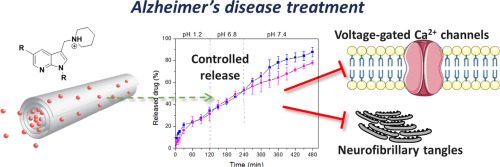当前位置:
X-MOL 学术
›
Appl. Clay. Sci.
›
论文详情
Our official English website, www.x-mol.net, welcomes your
feedback! (Note: you will need to create a separate account there.)
Clay-based hybrids for controlled release of 7-azaindole derivatives as neuroprotective drugs in the treatment of Alzheimer's disease
Applied Clay Science ( IF 5.3 ) Pub Date : 2020-05-01 , DOI: 10.1016/j.clay.2020.105541 Rocío García-Vázquez , Ediana P. Rebitski , Lucía Viejo , Cristóbal de los Ríos , Margarita Darder , Eva M. García-Frutos
Applied Clay Science ( IF 5.3 ) Pub Date : 2020-05-01 , DOI: 10.1016/j.clay.2020.105541 Rocío García-Vázquez , Ediana P. Rebitski , Lucía Viejo , Cristóbal de los Ríos , Margarita Darder , Eva M. García-Frutos

|
Abstract Hybrid systems based on clay minerals and 7-azaindole derivatives, which show an interesting neuroprotective profile in several in vitro models of neurodegeneration, were developed in order to facilitate the oral administration of these drugs in the treatment of Alzheimer's disease and provide a controlled release. Two 7-azaindole derivatives with different substitution at position 5 (-OCH3, -H) were synthesized and adsorbed on nanocarriers of different morphology, the lamellar clay montmorillonite (MMT) and the halloysite nanotubes (HNT). The drugs intercalation in MMT was confirmed by X-ray diffraction, obtaining basal spacing values around 1.9–2.0 nm in the hybrids, with a drug loading around 31–36 g per 100 g of MMT, while the HNT-based hybrids show an uptake of 15–21 g per 100 g of HNT. Studies carried out in cultures of human neuroblastoma cells confirmed the lack of toxicity of the hybrids and their neuroprotective effect against okadaic acid (OA), the inhibitor of the protein phosphatase 2A (PP2A), similarly to the non-encapsulated drugs. The release assays carried out in systems that simulate the gastrointestinal tract show a rapid release of the drugs from the hybrid materials, making necessary their encapsulation in a protective biopolymer matrix to slow down the release kinetics. A blend of alginate and zein was chosen for this purpose, exploiting the gelation of alginate with calcium ions to process the material as microbeads and the hydrophobic character of zein to reduce the water uptake of the material. Therefore, these bionanocomposite systems integrating the drug/clay hybrids seem promising for the oral administration of drugs with multitarget activity for the treatment of Alzheimer's disease.
中文翻译:

用于控制释放 7-氮杂吲哚衍生物作为治疗阿尔茨海默病的神经保护药物的粘土杂化物
摘要 开发了基于粘土矿物和 7-氮杂吲哚衍生物的混合系统,在几种体外神经变性模型中显示出有趣的神经保护作用,以促进这些药物在治疗阿尔茨海默病中的口服给药并提供控制释放. 合成了两种在 5 位具有不同取代基的 7-氮杂吲哚衍生物 (-OCH3, -H),并将其吸附在不同形态的纳米载体上,即层状粘土蒙脱石 (MMT) 和埃洛石纳米管 (HNT)。通过 X 射线衍射证实了 MMT 中的药物嵌入,在杂交体中获得约 1.9-2.0 nm 的基础间距值,每 100 g MMT 载药量约为 31-36 g,而基于 HNT 的杂交体显示出吸收每 100 克 HNT 含 15–21 克。在人类神经母细胞瘤细胞培养物中进行的研究证实,杂交体没有毒性,并且它们对冈田酸 (OA)(蛋白磷酸酶 2A (PP2A) 的抑制剂)的神经保护作用与非包封药物类似。在模拟胃肠道的系统中进行的释放试验表明,药物从混合材料中快速释放,需要将它们封装在保护性生物聚合物基质中以减缓释放动力学。为此选择了藻酸盐和玉米蛋白的混合物,利用藻酸盐与钙离子的胶凝作用将材料加工成微珠,并利用玉米蛋白的疏水特性来减少材料的吸水率。所以,
更新日期:2020-05-01
中文翻译:

用于控制释放 7-氮杂吲哚衍生物作为治疗阿尔茨海默病的神经保护药物的粘土杂化物
摘要 开发了基于粘土矿物和 7-氮杂吲哚衍生物的混合系统,在几种体外神经变性模型中显示出有趣的神经保护作用,以促进这些药物在治疗阿尔茨海默病中的口服给药并提供控制释放. 合成了两种在 5 位具有不同取代基的 7-氮杂吲哚衍生物 (-OCH3, -H),并将其吸附在不同形态的纳米载体上,即层状粘土蒙脱石 (MMT) 和埃洛石纳米管 (HNT)。通过 X 射线衍射证实了 MMT 中的药物嵌入,在杂交体中获得约 1.9-2.0 nm 的基础间距值,每 100 g MMT 载药量约为 31-36 g,而基于 HNT 的杂交体显示出吸收每 100 克 HNT 含 15–21 克。在人类神经母细胞瘤细胞培养物中进行的研究证实,杂交体没有毒性,并且它们对冈田酸 (OA)(蛋白磷酸酶 2A (PP2A) 的抑制剂)的神经保护作用与非包封药物类似。在模拟胃肠道的系统中进行的释放试验表明,药物从混合材料中快速释放,需要将它们封装在保护性生物聚合物基质中以减缓释放动力学。为此选择了藻酸盐和玉米蛋白的混合物,利用藻酸盐与钙离子的胶凝作用将材料加工成微珠,并利用玉米蛋白的疏水特性来减少材料的吸水率。所以,











































 京公网安备 11010802027423号
京公网安备 11010802027423号